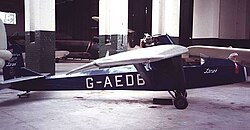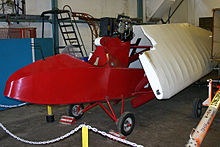BAC Drone
| BAC Drone | |
|---|---|
 Super Drone G-AEDB 1982 in Duxford |
|
| Type: | Microlight |
| Design country: | |
| Manufacturer: | |
| First flight: |
1932 |
| Number of pieces: |
33 |
The BAC Drone was an ultralight aircraft manufactured by the British Aircraft Company in the 1930s. After the dissolution of the company BAC, the successor Kronfeld Ltd. a few more copies.
history
The BAC Drone goes back to the BAC Planette , which was developed by CH Lowe-Wylde, the managing director and chief designer of the British Aircraft Company in Maidstone. A two-seat high-wing glider BAC VII served as the basis , on which he installed a motorcycle engine with a pusher propeller. In May 1933, Wylde was killed in an accident with this model.
BAC was then taken over by the Austrian glider pilot Robert Kronfeld , who revised the design of the Planette and replaced the previous engine with a more powerful 600 cm³ Douglas Sprite engine. After the company in Kronfeld Ltd. was renamed, the aircraft was renamed the Kronfeld Drone . However, the name BAC Drone is widely used in the literature . Of the total of 33 machines built, individual specimens were given as Super Drone and Drone de Luxe a slightly swept wing, slotted ailerons, an improved landing gear and a more powerful engine.
Special services
William Forbes-Sempill, who later became the 19th Lord Sempill, flew non-stop in a drone ( aircraft registration G-ADUA) from Croydon to Berlin in April 1936, covering the distance of 930 km in eleven hours. For the return flight the next day with a stopover in Canterbury, he only needed nine hours of flight time.
Whereabouts
The following are preserved:
- the Drone de Luxe G-AEKV equipped with a Carden-Ford engine , which was airworthy until 1984 and is currently (2014) owned by the Brooklands Museum in Surrey,
- G-ADPJ with a Bristol Cherub engine,
- G-AEDB in the Russavia collection in Duxford, which still flew in 1983.
Technical specifications
| Parameter | Data |
|---|---|
| crew | 1 |
| length | 6.45 m |
| span | 12.09 m |
| height | 2.13 m |
| Wing area | 16.0 m² |
| Wing extension | 9.1 |
| Climb performance | 1.9 m / s |
| Empty mass | 177 kg |
| payload | 118 kg |
| Cruising speed | 97 km / h |
| Top speed | 113 km / h |
| Service ceiling | 3800 m |
| Range | 480 km |
| Tank capacity | 45.4 l |
| Engines | a Douglas Sprite two-cylinder engine with 17 kW (23 hp) output, optionally also Bristol Cherub and Carden-Ford engines |
See also
literature
- Kronfeld Drone (planes from AZ) . In: AERO - the illustrated compilation of aviation, Marshall Cavendish, 1985, p. 2824
- John Fricker: Those draughty drone days . In: AIR International August 1983, pp. 79-82
Individual evidence
- ↑ Flight of November 12, 1936
- ^ Flight of March 18, 1937
- ^ AJ Jackson: British Civil Aircraft since 1919 - Volume 1 , Putnam & Company Ltd., 1973, ISBN 0-370-10006-9 , p. 174
